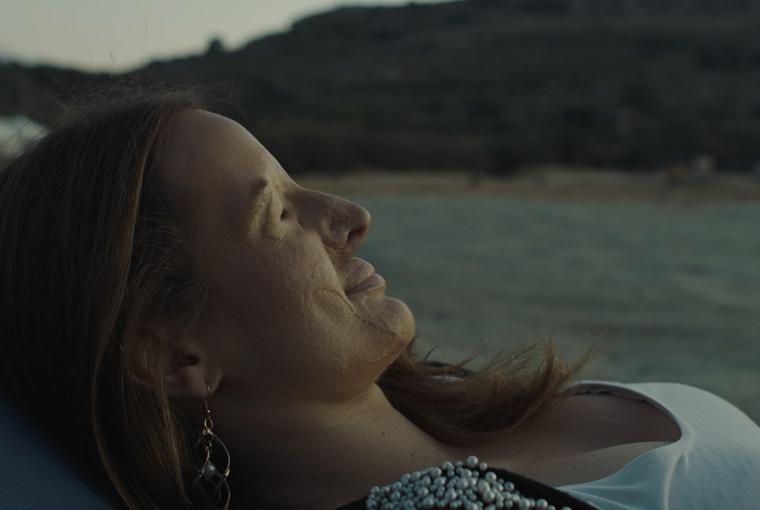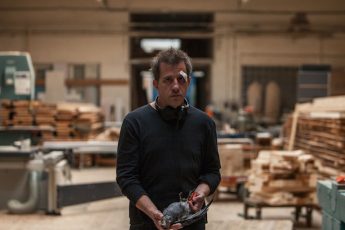Phoenix Rising
Jarmila Štuková’s Is There Any Place for Me, Please? (Moje nová tvář, 2023)
Vol. 144 (April 2024) by Martin Kudláč
Jarmila Štuková’s documentary Is There Any Place for Me, Please? is an intimate exploration of resilience and recovery following severe personal and physical trauma. The film, which received the Audience Award at the Ji.hlava International Documentary Film Festival 2023, documents the experiences of Martina Půtová from Plzeň. Půtová’s life has been dramatically altered by an acid attack perpetrated by her former partner, resulting in significant physical injuries and psychological impact. The documentary focuses on her journey through this transformation, matter-of-factly highlighting the challenges and milestones she encounters.
In the wake of the devastating acid attack, Martina Půtová faces a daunting road to recovery, marked by intense physical pain, numerous surgical interventions, and a challenging rehabilitation process. Štuková’s time-lapse documentary carefully chronicles the initial years following the attack, showcasing Půtová’s relentless determination to overcome the obstacles thrown in her path. Despite the significant physical consequences of the attack, which include near-total blindness, the film captures her unwavering resolve to reclaim her independence and sense of self.
The director’s methodical approach to storytelling emphasizes observation over sentimentality or simplification. Through this lens, Půtová’s journey is portrayed as one of profound personal growth. The documentary focuses not only on her physical struggles and the exhaustive process of medical treatment, but also on her internal battle to find strength and purpose in a new reality. Štuková successfully strikes a balance balance between depicting the harshness of Půtová’s experiences and highlighting her subject’s enduring courage and quest for a renewed life. The portrayal prompts viewers to reflect on the themes of survival, resilience, and the human capacity for regeneration and hope in the face of unimaginable adversity.
Štuková carefully avoids the pitfalls of melodrama, choosing instead to observe events as they unfold, thus granting a sense of dignity and autonomy to the protagonist. The director’s method is respectful of Půtová’s personal journey, presenting her not just as a passive recipient of misfortune but as an active seeker of resilience and purpose in the aftermath of her traumatic experience. This strategy ensures that Půtová’s narrative is conveyed with depth and authenticity, inviting viewers to connect with her story on a meaningful level without resorting to sensationalism.
However, the beginning of the protagonist’s transformation in the immediate wake of the attack –when she is just coming to terms with what has happened and how it will change her life – is tough to watch. During this part of the film, it is not always the cinematographer observing the protagonist, but Půtová herself who uses a camera to record her thoughts, emotions, and dilemmas. Eventually, the camera – whether it is in the hands of Štuková or Půtová herself – serves as a therapeutic tool.
The observational style adopted by the director facilitates a portrayal of Půtová that emphasizes her agency and the complexity of her recovery process. By focusing on Půtová’s efforts to rebuild her life and regain a sense of normalcy, the film transcends a simple victim narrative, offering instead a multifaceted exploration of her character and resilience. This approach encourages the audience to appreciate the nuances of Půtová’s experience, fostering empathy and understanding while avoiding the objectification or simplification of her struggles and thus steering clear of the pitfalls of trauma porn. Through this lens, the film becomes a platform for Půtová to share her journey of healing and self-discovery, underscoring the documentary’s commitment to presenting her story with integrity and sensitivity.
Is There Any Place for Me, Please? begins as a true crime documentary, and Půtová’s experience is not an exception. Similar instances of violence against women happen on a global scale. The perpetrator remains unmentioned throughout the whole documentary, which has become a convention in order not to give a platform to misogynist behavior (as opposed to the glamorization of serial killers, which has become a trend especially in American true crime circles). The documentary spans over a decade of Půtová’s life, capturing a wide range of emotional experiences.
The early years are marked by intense physical suffering and the daunting challenge of adjusting to an entirely new way of living. Despite these hardships, the film also highlights moments of genuine happiness resulting from small steps of improvement in the protagonist’s daily life, illustrating her remarkable journey towards autonomy and self-reliance through her engagement with the tactile world, her successful navigation of technologies designed for the visually impaired, and her accomplishment in completing a massage therapy course. The film documents the rediscovery of joy in life’s simple pleasures and her efforts to carve out a meaningful existence despite her near-total blindness.
The documentary lays emphasis on the psychological ramifications of Půtová’s ordeal. Beyond the physical scars and the challenges of adapting to visual impairment, the film provides an intimate examination of her mental health struggles. It candidly portrays her battles with anxiety, which are exacerbated by the numerous surgeries she undergoes, as well as her apprehensions concerning social interactions and new relationships in the wake of her trauma, especially towards men.
This dimension of the documentary reveals the depth of Půtová’s inner turmoil, offering a transparent view of the emotional and psychological hurdles that accompany her physical recovery. The pursuit of reclaiming her life entails a complete transformation, as the protagonist reveals that she had to completely rethink and reevaluate her life, which entails a significant personality change.
Půtová herself admits to having been a rather shallow person. The injury forced her to rewire her thinking and expectations from life, revealing that the experience made her be humbler and cherish simple things that brought her a kind of happiness she did not know before. Eventually her pursuit makes her into a layered individual who confronts and navigates her vulnerabilities and fears while striving towards healing and empowerment. The original Czech title, which translates into “My New Face”, reflects the fact that following the attack, her world widens and her expectations regarding life shift.
Is There Any Place for Me, Please? doesn’t simplify nor objectivize the protagonist’s suffering and trauma. Martina Půtová’s journey to recovery and reclaiming of agency and autonomy is thorny, though as her personality alters and adapts, levity and humor find their way into her story. She herself starts to take herself seriously, and even self-deprecating humor pops up. Even more, she finds a will to live and to continue the battle by becoming an activist, creating a support group, and using her own life story for education to help others.
Štuková’s documentary Is There Any Place For Me, Please? resonates with audiences, a fact underscored by its Audience Award win at Ji.hlava. This is no mere coincidence. The film charts a narrative of resilience, portraying the protagonist’s strenuous journey of reconstructing her life and rediscovering joy, thereby transforming a personal tragedy into a triumph. The transformation is depicted in a manner that is inspiring without resorting to overly clichéd expressions. Although the finale might lean towards corny sentimentality from a cinematic perspective, it is portrayed as being reflective of the protagonist’s real-life achievements.




Leave a Comment